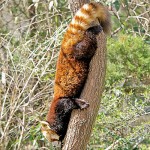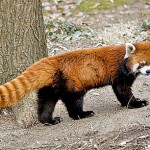THE RED PANDA
View(s):The red panda is dwarfed by the black-and-white giant that shares its name. The red panda has reddish-brown fur, a long, shaggy tail, and a waddling gait due to its shorter front legs. Its reddish-brown coat colour acts like camouflage in the canopy of fir trees where branches are covered with clumps of reddish-brown moss and white lichens.
These pandas typically grow to the size of a house cat, though their big, bushy tails add an additional 18 inches.
The pandas use their ringed tails as wraparound blankets in the chilly mountain heights.
Habitat and Behaviour
The red panda shares the giant panda’s rainy, high-altitude forest habitat, but has a wider range. Red pandas live in the mountains of Nepal and northern
Myanmar (Burma), as well as in central China.
These animals spend most of their
lives in trees and even sleep aloft. When
foraging, they are most active at night as well as in the gloaming hours of dusk and dawn.
Red pandas have a taste for bamboo but, unlike their larger relatives, they eat many other foods as well — fruit, acorns, roots and eggs. Like giant pandas, they have an extended wrist bone that
functions almost like a thumb and greatly aids their grip. When descending a tree head-first, the red panda rotates its ankle
to control its descent, one of the few climbing species to do so. Claws are for climbing,
of course, but this mild-
mannered animal can defend its territory by standing on its hind legs and using those sharp claws to strike out if threatened.
Breeding and Population
They are shy and solitary except when mating. Females give birth in the spring and summer,
typically to one to four young. Young
red pandas remain in their nests for about 90 days, during which time their mother cares for them. (Males take little or no interest in their offspring.)
The red panda has given scientists taxonomic fits. It has been classified as a relative of the giant panda, and also of the raccoon, with which it shares a ringed tail. Currently, red pandas are considered members of their own unique family — the Ailuridae.
Fully grown red pandas are preyed on by clouded leopards and snow leopards, while smaller red panda cubs are hunted by hawks, owls and other birds.
The main predators of red pandas are humans, who sometimes still hunt them for their skins and furs. Their natural space is shrinking as more and more forests are destroyed by logging and the spread of agriculture.
COMMON NAME: Red Panda
SCIENTIFIC NAME: Ailurus fulgens
IUCN RED LIST STATUS: Endangered
CLASSIFICATION: Mammal
LIFE SPAN: 8 years
DIET: Herbivore
SIZE: Head and body: 20 to 26 inches
Tail: 12 to 20 inches
WEIGHT: 12 to 20 pounds
Sources: National Geographic & JustFunFacts










